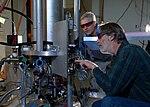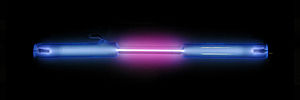A hydrogen maser, also known as hydrogen frequency standard, is a specific type of maser that uses the intrinsic properties of the hydrogen atom to serve...
7 KB (743 words) - 15:56, 24 August 2024
beam masers Ammonia maser Free electron maser Hydrogen maser Gas masers Rubidium maser Liquid-dye and chemical laser Solid state masers Ruby maser Whispering-gallery...
20 KB (2,226 words) - 05:01, 23 October 2024
intelligence. This line is the theoretical basis of the hydrogen maser. An atom of neutral hydrogen consists of an electron bound to a proton. The lowest...
31 KB (3,538 words) - 11:51, 1 August 2024
National Aeronautics and Space Administration. The experiment sent a hydrogen maser—a highly accurate frequency standard—into space to measure with high...
13 KB (1,667 words) - 17:48, 30 September 2024
Atomic clock (section Hydrogen)
1013. Hydrogen masers, which rely on the 1.4 GHz hyperfine transition in atomic hydrogen, are also used in time metrology laboratories. Masers outperform...
118 KB (12,664 words) - 04:53, 14 November 2024
to run one hydrogen maser clock in primary mode and a rubidium clock as hot backup. Under normal conditions, the operating hydrogen maser clock produces...
108 KB (10,782 words) - 05:13, 2 November 2024
"Atomic Hydrogen Welding". Specialty Welds. 2007. Archived from the original on 16 July 2011. Hardy, W. N. (2003). "From H2 to cryogenic H masers to HiTc...
121 KB (12,377 words) - 14:27, 16 September 2024
time of flight of light signals through a fiber optic link between two hydrogen maser clocks. In 1992 the experimental results were analyzed by Clifford Will...
44 KB (5,749 words) - 12:20, 2 November 2024
the array include arrival times from a local atomic clock, such as a hydrogen maser. At a later time, the data are correlated with data from other antennas...
21 KB (2,443 words) - 00:22, 11 October 2024
polarized hydrogen as the source of energy for the hydrogen maser. This led to developing an extremely stable clock based on a hydrogen maser. From 1967...
30 KB (3,470 words) - 04:47, 22 October 2024









